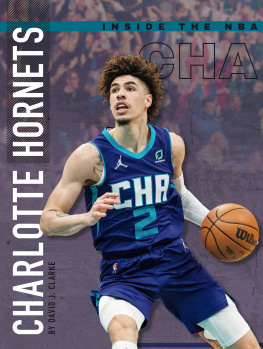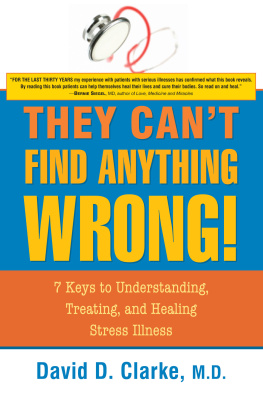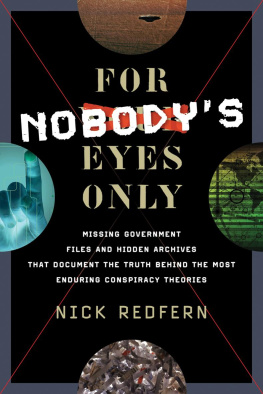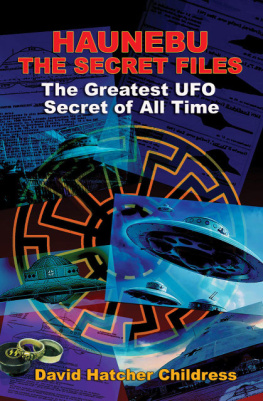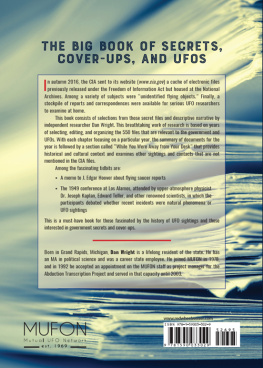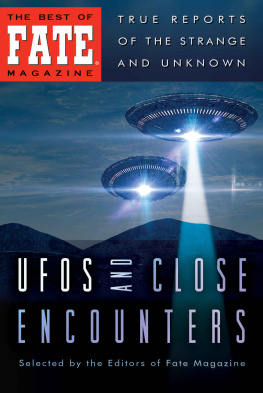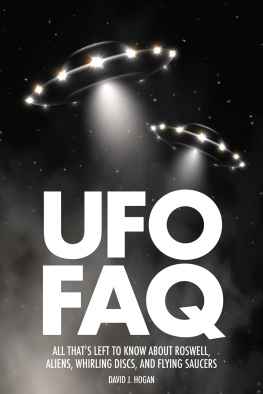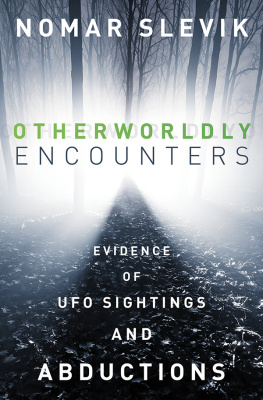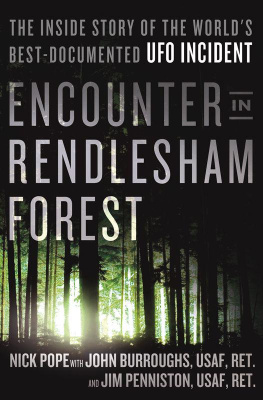
Contents
Special thanks to friends and fellow researchers who have provided assistance and material during the writing of this book (in no particular order): Keith Chester, Peter Hassall, Joe McGonagle, Gary Anthony, Andy Roberts, Nick Redfern, Martin Shough, Nigel Watson, Ian Ridpath, Joel Carpenter, Paul Fuller, John Rackham, Martyn Johnson, Mark Pilkington, John Rimmer, John Keeling, Peter Brookesmith, Jenny Randles, Rob Irving and Alex Birch.
Archive material: Thanks to the Ministry of Defence and in particular Linda Unwin, The British Library (St Pancras and Newspaper Library, Colindale), The Churchill Archive (University of Cambridge), BBC Written Archive, University of Bristol (Professor Cecil Powell archive), The Broadlands Archive (University of Southampton); Imperial War Museum archives.
I wish to thank all my colleagues at Bloomsbury and The National Archives whose hospitality, patience and attention to detail are much appreciated.
Introduction
Extraordinary Sightings by Ordinary People
This book is based upon the real-life accounts of UFO sightings recorded in files collected by Britains Ministry of Defence (MoD), which are today held by The National Archives, based at Kew, Richmond. The phrase close encounter was coined by an astronomer, Dr J. Allen Hynek, who acted as consultant to the US Air Forces UFO Project Blue Book between 1952 and 1969. He defined the typical UFO experience as a statement by a person or persons judged responsible and psychologically normal, describing an object or light in the sky that could not be explained by any obvious physical or psychological cause.
In the aftermath of the Second World War some countries, such as the United States, Canada and Great Britain, established official projects to collect and scrutinise unusual sighting reports for any clues that might suggest UFOs could be a threat to national security. In Britain, these were investigated by the Air Ministry and the MoD. But for many years the only publicly available information about the British governments UFO unit was its name, Secretariat Air Staff 2 or Sec(AS)2. The MoDs UFO files are often referred to as Britains real X-Files after the popular 90s TV show The X-Files, which chronicled the adventures of maverick FBI agents Fox Mulder and Dana Scully. The two fictional agents fought a battle with sinister forces who were determined to close down their investigations of strange phenomena. The overall theme of the series was summed up by an iconic poster in Mulders office that featured an image of a flying saucer with the caption: I want to believe.
The X-Files phenomenon reflected a widespread belief in the existence of extraterrestrial life that has grown since the end of the Second World War. Flying saucers were first sighted in 1947, but just seven years later an opinion poll for a London newspaper found that 16 per cent of Britons believed in them. The Cold War saw the launch of the Search for Extra Terrestrial Intelligence (SETI) and the success of the Apollo programme that put men on the moon. By the fiftieth anniversary of the UFO, another poll revealed that one third of the 1,092 adults questioned believed aliens had visited Earth and 21 of them claimed to have had a direct experience with E.T.!
Regardless of whether UFOs actually exist in the popular sense of flying saucers from other worlds, the subject is unquestionably part of our social and cultural history. The MoD files provide both an insight into UFO beliefs themselves and a unique database of reports from those who have seen them.
The files contain the stories, many first-hand, of ordinary people from all walks of life who have undergone extraordinary and often life-changing experiences. They usually take the form of short accounts submitted by phone or letter by those who felt they should report what they had seen to the authorities. UFO witnesses include people of all ages and professions, from schoolchildren and refuse collectors to police officers and RAF pilots.
The first surprise to emerge from the files is that although the terms flying saucer and UFO date from post 1945 era, the chronological spread of the documents actually begins before the First World War. They range from strange sightings made in the early 1900s and during both world wars, to the first reports of flying saucers during the late 1940s and 1950s, to contemporary accounts of stealthy, triangular-shaped craft. There are a great variety of stories and some are far more credible than others. Some describe the classic lights and shapes in the sky that were categorised as close encounters of the first kind by Dr Hynek. Others involve close encounters of the second kind, where some form of physical evidence such as marks on the ground or photographs have been left behind. A small number describe encounters of the third kind: sightings of UFO occupants and even alleged alien abductions.
The most recent of these documents were opened to the public under the Freedom of Information Act (FOIA) in a four-year programme that ended in 2012. The Ministry of Defence described the release as a major exercise that was unique in MoD history. Their aim was that greater openness would help counter what they described as the maze of rumour and frequently ill-informed speculation that surrounded their involvement, both real and imagined, in the UFO mystery. But for those who suspected a whitewash, many questions remained. What did the files contain that justified them being kept secret for so many years? Why was government releasing them now? And how can we be sure these files really do contain the truth? This book is both an account of my attempt to answer those questions and a history of official investigations into the UFO mystery in the United Kingdom. During the past decade I have methodically ploughed through every surviving UFO-related file held by The National Archives, including all the records on 12,000 sightings recorded in official files since 1962. Between 2008 and 2012 I was the consultant and media spokesman for The National Archives project that prepared the most recent files for release. This high-profile role was the culmination of my own personal quest to discover what the British government really knew about UFOs.
I first became gripped by the UFO bug in 1978 on seeing Steven Spielbergs movie Close Encounters of the Third Kind. Inspired by the true-life experiences upon which the movie was supposed to be based, I joined a UFO society and began to collect accounts of sightings. But my first close encounter with the real X-files happened a decade later when I was a rookie journalist. In 1988 hundreds of people in the Midlands and North of England reported seeing strange lights and objects in the sky. After writing about these experiences for my newspaper, I compiled a dossier of the most impressive eye-witness reports and decided to send it to the fabled UFO desk at Whitehall.
The letter said the MoD had only a passing interest in UFO reports. There was, he explained, no department within the MoD that was solely responsible for the investigation of sightings or anyone employed full-time to investigate sightings, so any comparison with Project Blue Book was misleading. Their only concern was to decide if UFOs present a threat to the security and defence of the United Kingdom. Reports were forwarded to specialist staff in other branches responsible for the air defence of the UK for examination. But unless clear evidence of a threat was identified, and this is not normally the case, no attempt was made to investigate or categorise them.
Next page


